Geodetic Evidence That Mercury Has A Solid Inner Core
Author(s)
Genova, Antonio; Goossens, Sander; Mazarico, Erwan; Lemoine, Frank G.; Neumann, Gregory A.; Kuang, Weijia; Sabaka, Terence J.; Hauck, Steven A. II; Smith, David Edmund; Solomon, Sean C.; Zuber, Maria; ... Show more Show less
DownloadAccepted version (1.069Mb)
Open Access Policy
Open Access Policy
Creative Commons Attribution-Noncommercial-Share Alike
Terms of use
Metadata
Show full item recordAbstract
Geodetic analysis of radio tracking measurements of the MErcury Surface, Space ENvironment, GEochemistry, and Ranging spacecraft while in orbit about Mercury has yielded new estimates for the planet's gravity field, tidal Love number, and pole coordinates. The derived right ascension (α = 281.0082° ± 0.0009°; all uncertainties are 3 standard deviations) and declination (δ = 61.4164° ± 0.0003°) of the spin pole place Mercury in the Cassini state. Confirmation of the equilibrium state with an estimated mean (whole planet) obliquity ϵ of 1.968 ± 0.027 arcmin enables the confident determination of the planet's normalized polar moment of inertia (0.333 ± 0.005), which indicates a high degree of internal differentiation. Internal structure models generated by a Markov Chain Monte Carlo process and consistent with the geodetic constraints possess a solid inner core with a radius (ric) between 0.3 and 0.7 that of the outer core (roc).
Date issued
2019-04Department
Massachusetts Institute of Technology. Department of Earth, Atmospheric, and Planetary SciencesJournal
Geophysical Research Letters
Publisher
American Geophysical Union (AGU)
Citation
Genova, Antonio, et al. "Geodetic Evidence That Mercury Has A Solid Inner Core." Geophysical Research Letters 46:7(April 2019): 3625–3633 © 2019 Author(s)
Version: Author's final manuscript
ISSN
0094-8276
1944-8007